Abstract
Genetic complexity of processes governing the aging rate of man was estimated by determining the maximum rate lifespan has evolved along the hominid ancestral-descendant sequence. Maximum lifespan potential was found to have increased approximately 2-fold over the past 3 million years, reaching a maximum rate of increase of 14 years per 100,000 years about 100,000 years ago. It is estimated that about 0.6% of the total functional genes have received substitutions leading to one or more adaptive amino acid changes during this 100,000-year time-period. This suggests that aging is not the result of an expression of a large number of independently acting processes. Instead, primary aging processes appear to exist where only a few genetic changes are necessary to decrease uniformly the aging rate of many different physiological functions.
Full text
PDF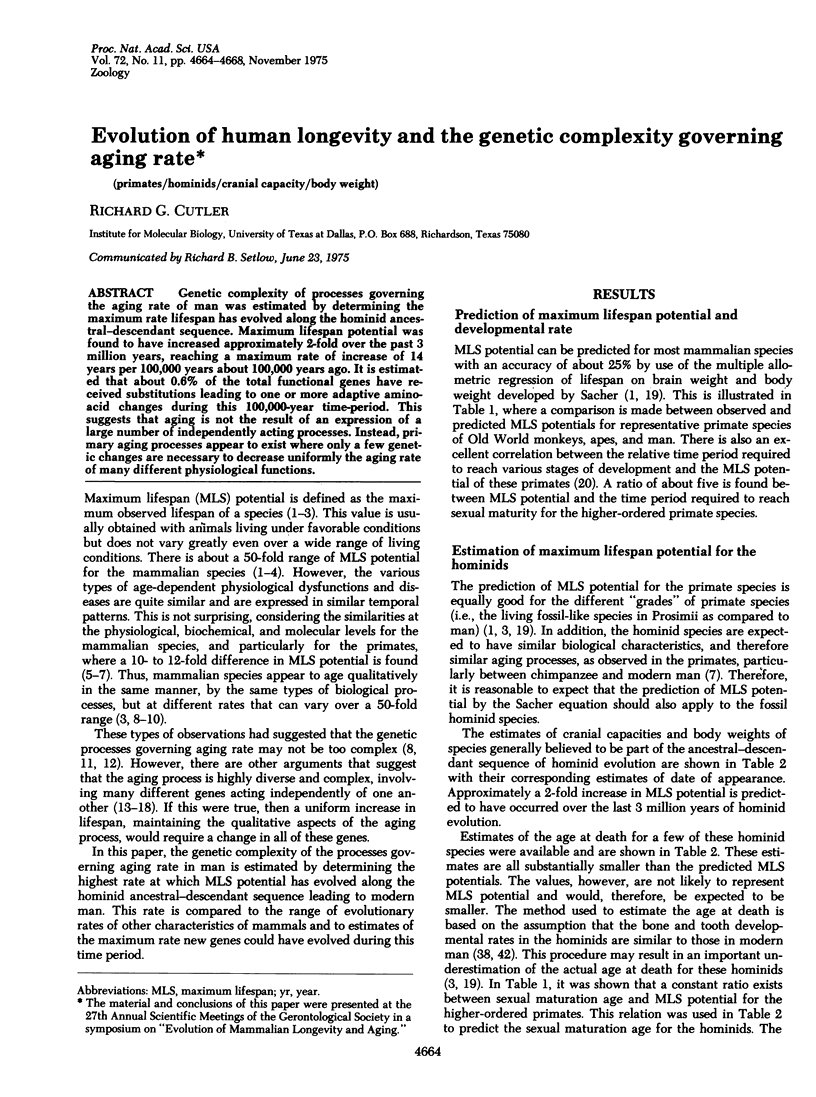
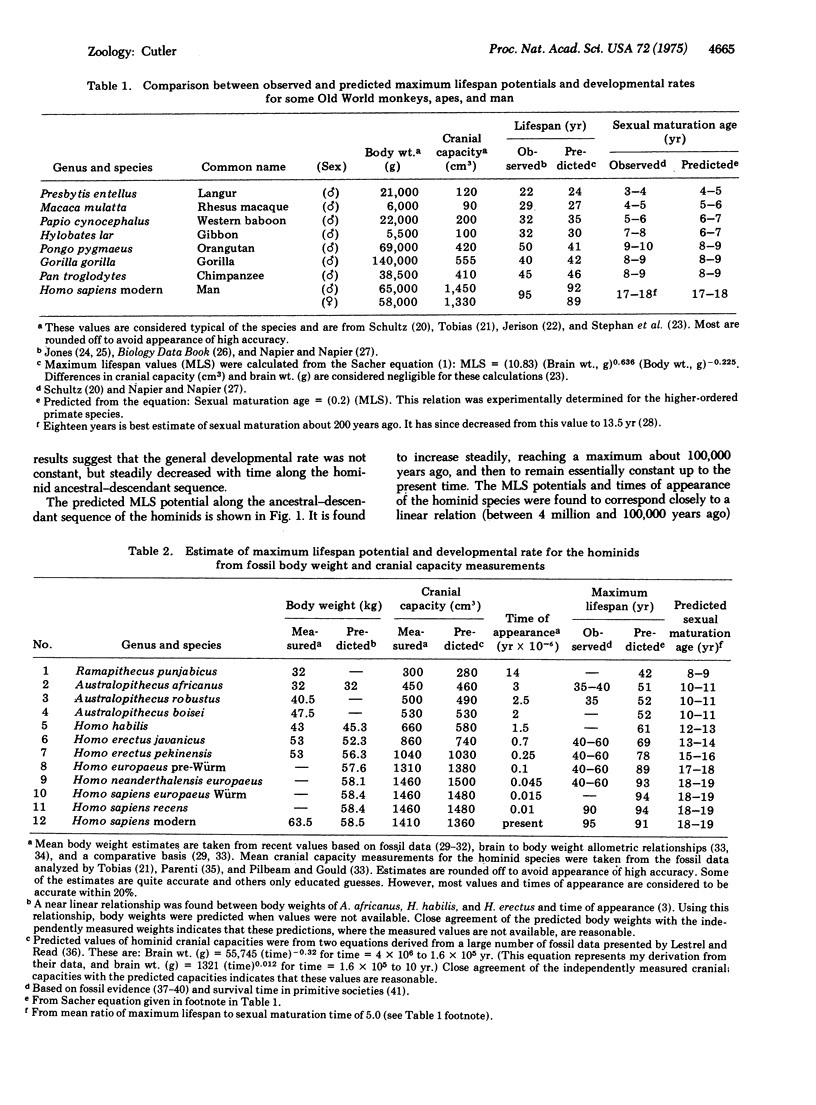
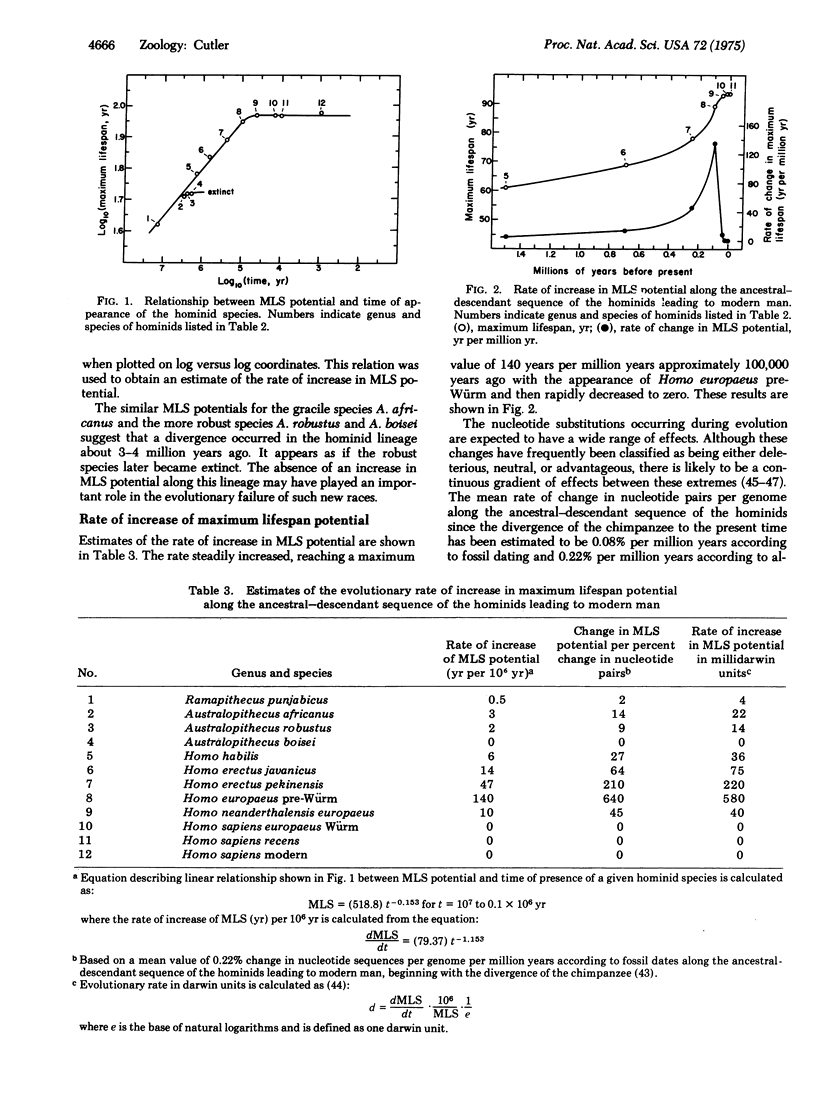
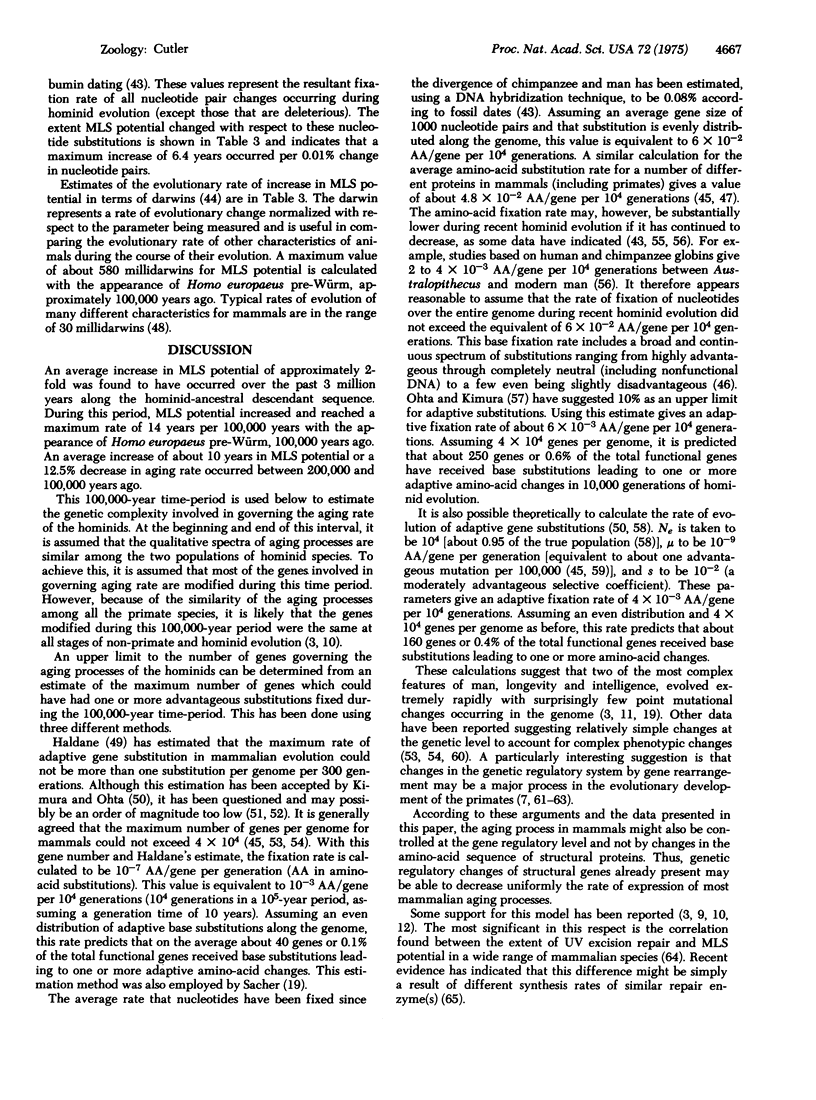
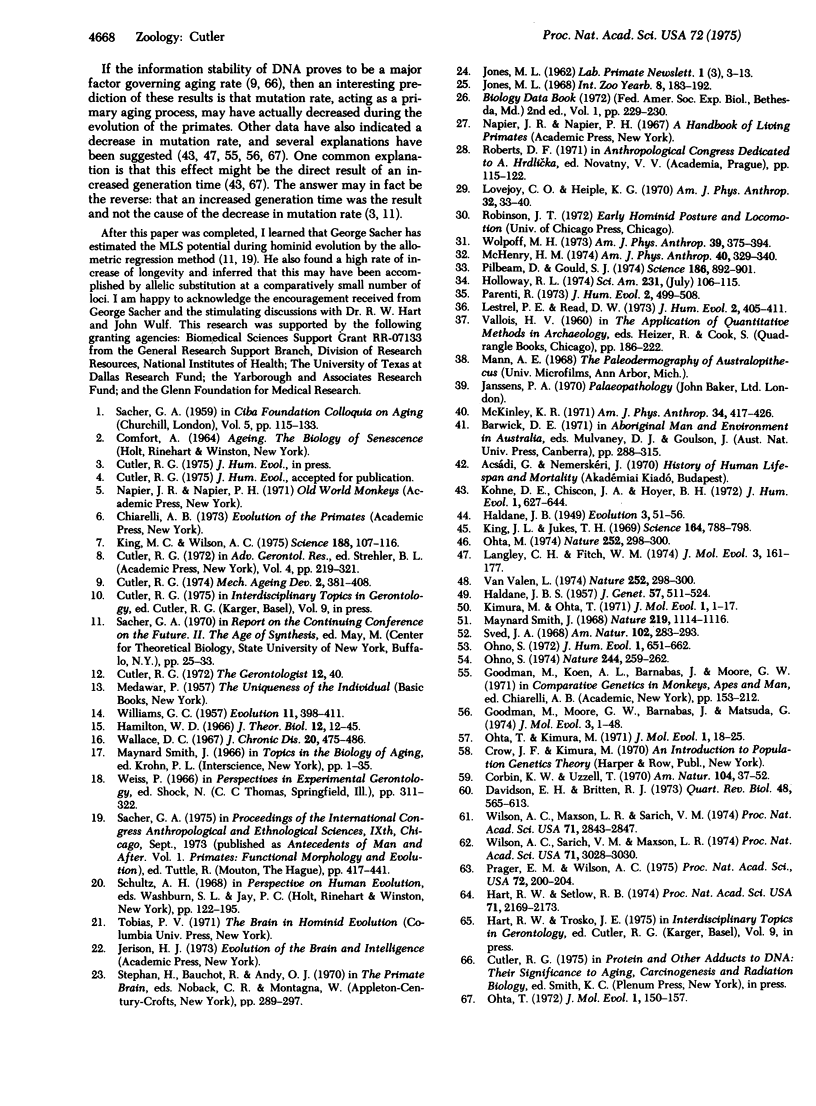
Selected References
These references are in PubMed. This may not be the complete list of references from this article.
- Cutler R. G. Redundancy of information content in the genome of mammalian species as a protective mechanism determining aging rate. Mech Ageing Dev. 1973 Dec;2(6):381–408. doi: 10.1016/0047-6374(73)90032-8. [DOI] [PubMed] [Google Scholar]
- Davidson E. H., Britten R. J. Organization, transcription, and regulation in the animal genome. Q Rev Biol. 1973 Dec;48(4):565–613. doi: 10.1086/407817. [DOI] [PubMed] [Google Scholar]
- Goodman M., Moore G. W., Barnabas J., Matsuda G. The phylogeny of human globin genes investigated by the maximum parsimony method. J Mol Evol. 1974 Feb 28;3(1):1–48. doi: 10.1007/BF01795974. [DOI] [PubMed] [Google Scholar]
- Hamilton W. D. The moulding of senescence by natural selection. J Theor Biol. 1966 Sep;12(1):12–45. doi: 10.1016/0022-5193(66)90184-6. [DOI] [PubMed] [Google Scholar]
- Hart R. W., Setlow R. B. Correlation between deoxyribonucleic acid excision-repair and life-span in a number of mammalian species. Proc Natl Acad Sci U S A. 1974 Jun;71(6):2169–2173. doi: 10.1073/pnas.71.6.2169. [DOI] [PMC free article] [PubMed] [Google Scholar]
- Holloway R. L. The casts of fossil hominid brains. Sci Am. 1974 Jul;231(1):106–115. doi: 10.1038/scientificamerican0774-106. [DOI] [PubMed] [Google Scholar]
- Kimura M., Ota T. On the rate of molecular evolution. J Mol Evol. 1971;1(1):1–17. doi: 10.1007/BF01659390. [DOI] [PubMed] [Google Scholar]
- King J. L., Jukes T. H. Non-Darwinian evolution. Science. 1969 May 16;164(3881):788–798. doi: 10.1126/science.164.3881.788. [DOI] [PubMed] [Google Scholar]
- King M. C., Wilson A. C. Evolution at two levels in humans and chimpanzees. Science. 1975 Apr 11;188(4184):107–116. doi: 10.1126/science.1090005. [DOI] [PubMed] [Google Scholar]
- Langley C. H., Fitch W. M. An examination of the constancy of the rate of molecular evolution. J Mol Evol. 1974;3(3):161–177. doi: 10.1007/BF01797451. [DOI] [PubMed] [Google Scholar]
- Lovejoy C. O., Heiple K. G. A reconstruction of the femur of Australopithecus africanus. Am J Phys Anthropol. 1970 Jan;32(1):33–40. doi: 10.1002/ajpa.1330320105. [DOI] [PubMed] [Google Scholar]
- McKinley K. R. Survivorship in gracile and robust australopithecines: a demographic comparison and a proposed birth model. Am J Phys Anthropol. 1971 May;34(3):417–426. doi: 10.1002/ajpa.1330340311. [DOI] [PubMed] [Google Scholar]
- Ota T., Kimura M. On the constancy of the evolutionary rate of cistrons. J Mol Evol. 1971;1(1):18–25. doi: 10.1007/BF01659391. [DOI] [PubMed] [Google Scholar]
- Pilbeam D., Gould S. J. Size and scaling in human evolution. Science. 1974 Dec 6;186(4167):892–901. doi: 10.1126/science.186.4167.892. [DOI] [PubMed] [Google Scholar]
- Prager E. M., Wilson A. C. Slow evolutionary loss of the potential for interspecific hybridization in birds: a manifestation of slow regulatory evolution. Proc Natl Acad Sci U S A. 1975 Jan;72(1):200–204. doi: 10.1073/pnas.72.1.200. [DOI] [PMC free article] [PubMed] [Google Scholar]
- Van Valen L. Two modes of evolution. Nature. 1974 Nov 22;252(5481):298–300. doi: 10.1038/252298a0. [DOI] [PubMed] [Google Scholar]
- Van Valen L. Two modes of evolution. Nature. 1974 Nov 22;252(5481):298–300. doi: 10.1038/252298a0. [DOI] [PubMed] [Google Scholar]
- Wallace D. C. The inevitability of growing old. J Chronic Dis. 1967 Jul;20(7):475–486. doi: 10.1016/0021-9681(67)90079-3. [DOI] [PubMed] [Google Scholar]
- Wilson A. C., Maxson L. R., Sarich V. M. Two types of molecular evolution. Evidence from studies of interspecific hybridization. Proc Natl Acad Sci U S A. 1974 Jul;71(7):2843–2847. doi: 10.1073/pnas.71.7.2843. [DOI] [PMC free article] [PubMed] [Google Scholar]
- Wilson A. C., Sarich V. M., Maxson L. R. The importance of gene rearrangement in evolution: evidence from studies on rates of chromosomal, protein, and anatomical evolution. Proc Natl Acad Sci U S A. 1974 Aug;71(8):3028–3030. doi: 10.1073/pnas.71.8.3028. [DOI] [PMC free article] [PubMed] [Google Scholar]
- Wolpoff M. H. Posterior tooth size, body size, and diet in South African gracile Australopithecines. Am J Phys Anthropol. 1973 Nov;39(3):375–393. doi: 10.1002/ajpa.1330390306. [DOI] [PubMed] [Google Scholar]


